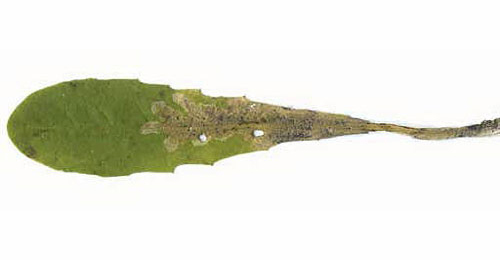|
||||||
|
Ophiomyia
cunctata (Hendel, 1920) Melanagromyza
cunctata Hendel, 1920. Arch. Naturgesch. 84A(7)
(1918): 126 |
|||||||||||||||||||||||||||||||||||||||||||||||||||||||||||||||||||||||||||||||||||||||||||||||||||||||||||||||||||||||||||||||||||||||||||||||||||||||||||||||||||||||||||||||||||||||||||||||||||||||||||||||||||||||||||||||||||||||||||||
Leaf-miner: A whitish blotch mine along mid-rib, with offshoots into leaf blade. Pupation takes place at the base of the mid-rib (Spencer, 1972b: 25; Spencer. 1976: 63 (fig. 66)). The mine begins as a very narrow, upper- or lower-surface corridor, somewhere in the blade. When this hits a thick vein the larva uses this to descend towards the midrib. From that moment the lave lives in the hollow midrib. From here short, lobate corridors enter the leaf blade. The larva may move to another leaf by way of the leaf base. The corridors in the leaf are virtually free of frass (at most a few grains where they leave the midrib); frass is concentrated in the base of the midrib. Here also the pupation takes place (Bladmineerders van Europa).
Larva: The larvae of flies are leg-less maggots without a head capsule (see examples). They never have thoracic or abdominal legs. They do not have chewing mouthparts, although they do have a characteristic cephalo-pharyngeal skeleton (see examples), usually visible internally through the body wall. The larva is described by de Meijere (1925: 252 as O. sp. and 1934). Posterior spiracles are on short stalks, each with an ellipse of 9 bulbs (Spencer, 1972b: 25). The larva is illustrated in Bladmineerders van Europa. Puparium: The puparia of flies are formed within the hardened last larval skin or puparium and as a result sheaths enclosing head appendages, wings and legs are not visible externally (see examples). Yellowish white; posterior spiracles are on short stalks, each with an ellipse of 9 bulbs (Spencer, 1972b: 25). The puparium is illustrated in Bladmineerders van Europa. Comments: Picris echioides is treated as Helminthotheca echioides (Bristly Oxtongue) by Stace (2010). Hosts in Great Britain and Ireland:
Hosts elsewhere:
Time of year - mines: July-October. Time of year - adults: Currently unknown. Distribution in Great Britain and Ireland: Widespread in Britain including Kent (Dartford), London (Hampstead), Isle of Wight (Blackgang Chine), Gloucester. (Coombe Dingle), Hertfordshire (Tring), Suffolk (Newmarket), Lancashire (Formby), Dunbartonshire (Bonhill) (Spencer, 1972b: 25); Warwickshire (Coventry, Fazeley Canal and Foleshill) (Robbins, 1991: 123); Cambridgeshire, East Gloucestershire, Glamorgan, Northamptonshire, South Lancashire and South-west Yorkshire (NBN Atlas). Distribution elsewhere: Widespread throughout much of Europe including Denmark, Finland, Norway, Sweden (Spencer, 1976: 62), The Netherlands (Bladmineerders van Europa), Albania, Austria, Balearic Is., Canary Is., Czech Republic, European Turkey, French mainland, Germany, Hungary, Italian mainland, Lithuania, Poland, Republic of Moldova, Slovakia and Spanish mainland (Fauna Europaea). NBN Atlas links to known host species:
British and Irish Parasitoids in Britain and elsewhere:
|
|
|
|
| External links: | Search the internet: |
| Biodiversity Heritage Library Bladmineerders van Europa British leafminers Encyclopedia of Life Fauna Europaea NBN Atlas NHM UK Checklist |
Find
using Google Find using Google Scholar Find images using Google |
| Last updated 10-Jul-2019 Brian Pitkin | ||

